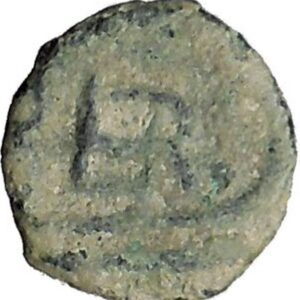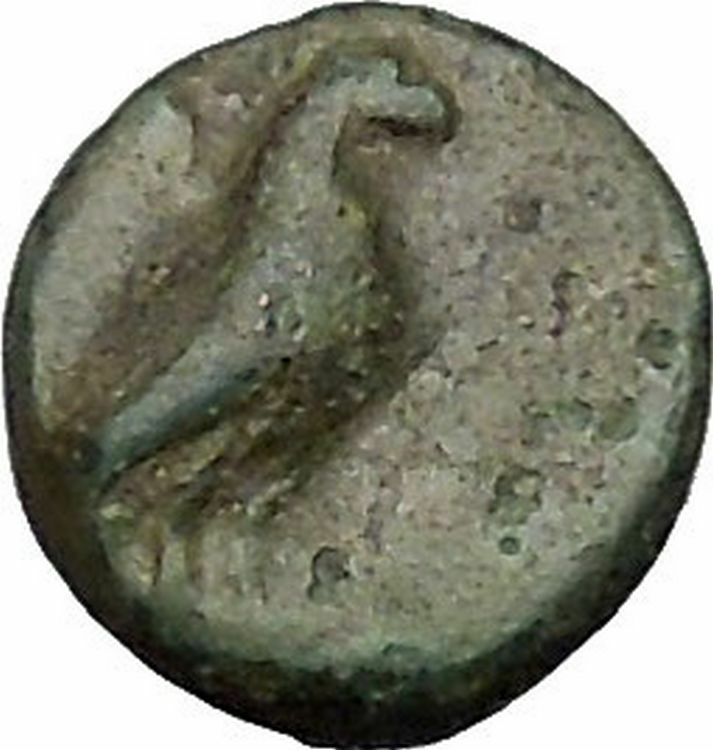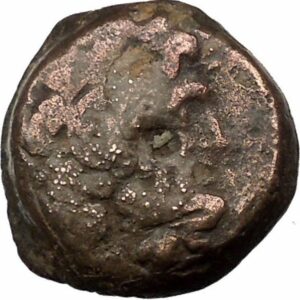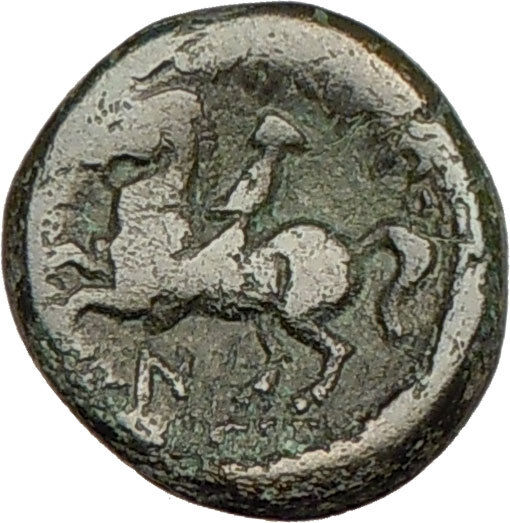|
Greek coin of the
Lycian League
Silver Hemidrachm 14mm (1.41 grams)
Masikytes mint
Lycia, struck circa 48-42 B.C.
Reference: Troxell Period IV, Series 1, 87.3;
RPC I 3301
Laureate head of Apollo right.
Lyre; plectrum to lower left; M – A in fields; all
within rectangular incuse.
Masikytes was a mountainous region of central southern Lycia,
east of the Xanthos river. It would seem that Myra was the chief town of the
Monetary District and the principal mint for the coinage issued in the name of
Masikytes. Situated on the river Myros, close to the sea, Myra was an important
town and principal mint for the Monetary District of Masikytes.
You are bidding on the exact item pictured,
provided with a Certificate of Authenticity and Lifetime Guarantee of
Authenticity.

In
Greek
and
Roman mythology
,
Apollo, is one of the most
important and diverse of the
Olympian deities
. The ideal of the
kouros
(a beardless youth), Apollo has been
variously recognized as a god of light and the sun; truth and prophecy;
archery
; medicine and healing; music, poetry,
and the arts; and more. Apollo is the son of
Zeus and Leto
, and has a
twin
sister, the chaste huntress
Artemis
. Apollo is known in Greek-influenced
Etruscan mythology
as Apulu. Apollo was
worshiped in both
ancient Greek
and
Roman religion
, as well as in the modern
Greco
–Roman
Neopaganism
.
As the patron of Delphi
(Pythian Apollo), Apollo was an
oracular
god — the prophetic deity of the
Delphic Oracle
. Medicine and healing were
associated with Apollo, whether through the god himself or mediated through his
son Asclepius
, yet Apollo was also seen as a god
who could bring ill-health and deadly
plague
as well as one who had the ability to
cure. Amongst the god’s custodial charges, Apollo became associated with
dominion over
colonists
, and as the patron defender of herds
and flocks. As the leader of the
Muses (Apollon Musagetes) and director of their choir, Apollo
functioned as the patron god of music and
poetry
.
Hermes
created the
lyre for him, and the instrument became a common
attribute
of Apollo. Hymns sung to Apollo were
called paeans
.
In Hellenistic times, especially during the third century BCE, as Apollo
Helios he became identified among Greeks with
Helios
,
god of the sun
, and his sister Artemis
similarly equated with
Selene
,
goddess of the moon
. In Latin texts, on the
other hand, Joseph Fontenrose declared himself unable to find any conflation of
Apollo with
Sol
among the
Augustan poets
of the first century, not even
in the conjurations of
Aeneas
and
Latinus
in
Aeneid
XII (161–215). Apollo and Helios/Sol
remained separate beings in literary and mythological texts until the third
century CE.
Lycian League
LYCIAN LEAGUE
τὸ Λυκιακοῦ σύστημα
| City |
Votes |
| Xanthos
|
3 |
|
Patara
|
3 |
| Myra
|
3 |
| Pinara
|
3 |
| Tlos
|
3 |
|
Olympos
|
3 |
Sympolity of
Aperlae
,
Simena
,
Isinda
,
Apollonia
|
1 |
| Amelas
|
? |
|
Antiphellus
|
? |
| Arycanda
|
? |
|
Balbura
|
? |
|
Bubon
|
? |
| Cyaneae
|
? |
|
Dias
|
? |
| Gagae
|
? |
| Idebessos
|
? |
| Limyra
|
? |
| Oenoanda
|
? |
| Phaselis
|
? |
| Phellus
|
? |
|
Podalia
|
? |
|
Rhodiapolis
|
? |
| Sidyma
|
? |
|
Telmessus
|
? |
| Trebenna
|
? |
Formation
The Lycian League (Lukiakou systema in Strabo’s Greek transliterated, a
"standing together") is first known from two inscriptions of the early 2nd
century BC in which it honors two citizens. Bryce hypothesizes that it was
formed as an agent to convince Rome to rescind the annexation of Lycia to
Rhodes
. Lycia had been under Rhodian control
since the
Peace of Apamea
in 188 BC. A fragment from
Livy records a "pitiful embassy" in 178 BC from Lycia to the Roman
Senate complaining that the Lycians were being treated as slaves. Whipping had
been instituted as corporeal punishment and the women and children were being
abused. The Romans sent back a stern warning with the Lycians to Rhodes saying
that they had not intended the Lycians or any other people born in freedom to be
enslaved by Rhodes, and that the assignment was only a protectorate. A fragment
from Polybius
tells a slightly different version of
the story, which has the Romans sending legates to Rhodes to say that "the
Lycians had not been handed over to Rhodes as a gift, but to be treated like
friends and allies." The Rhodians sent an embassy in return claiming that the
Lycians had made the story up for reasons of their own and that in fact they
were a financial burden on Rhodes.
The continuation of the story did not survive, but in 168 BC, Rome took Lycia
away from Rhodes and turned over home rule to the League. There was no question
of independence. Lycia was not to be sovereign, only self-governing under
republican principles. It could neither negotiate with foreign powers nor
disobey the Roman Senate. It was not independent. It could govern its own people
and for a time mint its own coins as a right granted by Rome. It did not
determine its own borders. Land and people could be assigned or taken away by
the Senate. Remarking on this protectorate Strabo says of the government:
"Formerly they deliberated about war and peace, and alliances, but this
is not now permitted, as these things are under the control of the Romans.
It is only done by their consent, or when it may be for their own
advantage."
Exactly what such a statement might imply is uncertain. Lycia had not been a
sovereign state for some time. Whether the Lycian League as such is meant,
implying that it existed anciently, or some other similar government is meant,
is not clear. The statement does not say also whether there was a gap between
the former sovereign state and the new Lycian League, or whether they are to be
conceived as chronologically continuous.
Composition
According to Strabo, the league comprised some 23 known
city-states
as members.
Lucius Licinius Murena
(elder), Roman consul,
added three more in 81 BC:
Balbura
,
Bubon
and
Oenoanda
, which he had stripped from another
systema to the north, the Tetrapolis, Cibyratis, or Cabalian League. It was
dominated by the city of Cibyra (Kibyra),
which formed a league approximately contemporaneously with the Lycian League.
Cibyra ruled the
Turkish Lakes Region
. It was called Cibyra
Megale, "Greater Cibyra," to distinguish it from
Cibyra Mikra
or "Little Cibyra" (today near
Okurcalar) near Side
. The lakes region is a string of alpine
valleys in the folds of the Taurus Mountains, which have no natural exits.
Instead they have collected lakes. Cibyra was on a low hill to the west of
Gölhisar Valley and Gölhisar Lake, just north of
Gölhisar
.
Cibyra dominated an ancient region, Cabalis, which was divided between the
later states of Lycia,
Pisidia
and
Lydia
, subsequently incorporated in
Phrygia
. According to Strabo, it spoke four
languages,
Lydian
, even though Lydian had disappeared
elsewhere, Greek, Pisidian and "that of the
Solymi
." Cabalis, which was later divided into
Lycian and Asian Cabalis, was the putative home of the Solymi. It included the
Milyas District of Lycia, putatively the home of the first Lycians. It is
possible that they spoke a form of Anatolian earlier than the attested Lycian,
which some have dubbed "Milyan." A further connection of this "Milyan" with
Lycian B of the
Xanthian Obelisk
is pure fantasy.
Unlike the Lycian League, the Cibyratis was ruled by a succession of
deliberately ostentatious and high-handed tyrants. Having become a thorn in the
side of Rome, they attracted the attention of
Gnaeus Manlius Vulso
, commander of the Roman
armies successfully fighting the
Galatian War
of 189 BC. Manlius turned toward
Cibyratis with the intent of removing the thorn. The tyrant, Moagetes, barely
escaped with his life and his position by entering the Roman camp dressed in
humble clothing, with a handful of similarly dressed assistants, claiming
destitution and begging for mercy. He offered a payment of 15 talents. Manlius
set the payment at 500 talents, a huge sum, impossible of payment. Finally moved
to mercy, he allowed Moagetes to bargain him down to 100 and a substantial
payment of grain, necessary to the Roman commissary.
When the Romans had departed Moagetes dropped the pretense, and Cibyratis
resumed its arrogance. Consequently, when Murena did finally deal with Cibyratis,
he had no political mercy. Strabo says that Bubon and Balbura were transferred
to the Lycian League forthwith. He does not mention Oenoanda, but it had been a
city of the Lycians anyway. It minted coinage of the League subsequently. There
is no evidence that Cibyra was ever admitted to the League, although that
assumption sometimes is made. It was in Asian Cabalia and as such was joined to
Phrygia later, an event supported by their coin issues. The last tyrant of the
Tetrapolis was also named Moagetes, a different one, unless the term was a
title, or Strabo made a mistake.
The 23 at first and then 26 city states joined together in a federal-style
government that shared political and economic resources. A “Lyciarch” was
elected by a senate (συνέδριον, synedrion, "sitting together") that convened by
agreement beforehand at "what city they please." Each member had one, two or
three votes (presumably by different representatives), depending on the city’s
size. The diminishment of some cities over time caused them to join with the
major state in their vicinity to form a sympolity. In that case they lost their
vote (if they had one) assuming an influence in the vote of the major city.
After election of the Lyciarch the Senate voted for the other public officials
and the magistrates. The League’s government took precedence, but, as in many
federal systems, the issue was not entirely settled, and the resulting civil
conflict led to the dissolution of the union.
Strabo identified the major cities of the League; that is, the three-vote
cities, as Xanthos
,
Patara
,
Pinara
,
Olympos
,
Myra, and Tlos
, with Patara as the capital. The full
complement has been identified by a study of the coins and mention in other
texts. The coins recognize two districts, termed, for want of a better term,
"monetary districts:" Masicytus and Cragus, both named after mountain ranges, in
the shadow of which, presumably, the communities lived and conducted business.
Where coinage before the Lycian League had often been stamped LY for Lycia, it
was now stamped KP (kr) or MA.
Treaty with Rome
An inscription from Tyberissos records the treaty between Rome and Lycian
League, which is of a type the Romans called a foedus. It was much used
between Italian cities and Rome, except that their treaties provided for
contributions to Rome, but this one does not. There is a general statement and
four clauses. The general statement establishes "peace, friendship, and loyal
alliance … by land and sea for all time." The four clauses provide for
neutrality of Rome to the enemies of the Lycian League, neutrality of the Lycian
League to the enemies of Rome, mutual assistance in the case of first aggression
by an enemy against either, and alteration of the treaty only by joint
agreement. The treaty is written as though between independent and co-equal
states, but all parties knew that this was conventional hypocrisy. The Lycian
League was subject to the decisions of the Roman Senate and the decrees of the
Roman emperors, but not vice versa. Only the Roman state was powerful.
Roman period
Main article:
Lycia et Pamphylia
In 43 AD, the emperor
Claudius
annexed Lycia to the
Roman Empire
as a province and by the time of
Vespasian
, it was united with
Pamphylia
as a Roman province. The heir of
Augustus
,
Gaius Caesar
, was killed there in 4 AD.
Myra is an ancient town in
Lycia
, where the small town of Kale (Demre)
is situated today in present day
Antalya Province
of
Turkey
. It was located on the river Myros (Demre
Çay), in the fertile
alluvial plain
between Alaca Dağ, the
Massikytos range and the
Aegean Sea
.
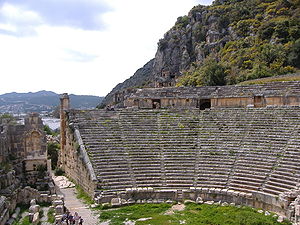
Ancient Greek theatre
of Myra, with
the rock-cut tombs of the ancient
Lycian
necropolis
on the cliff in the
background.
//
Historical
evidence
Although some scholars equate Myra with the town Mira in
Arzawa
, there is no proof for the connection.
There is no substantiated written reference for Myra before it was listed as a
member of the Lycian alliance (168
BC – AD 43); according to
Strabo
(14:665) it was one of the largest towns
of the alliance.
The
Greek
citizens worshipped
Artemis
Eleutheria
, who was the protective goddess of
the town. Zeus
,
Athena
and
Tyche
were venerated as well.
The ruins of the Lycian and Roman town are mostly covered by alluvial silts.
The Acropolis
on the Demre-plateau, the Roman
theatre
and the
Roman baths
(eski hamam) have been
partly excavated. The semi-circular theater was destroyed in an
earthquake
in 141, but rebuilt afterwards.

Rock-cut tombs in Myra.
There are two
necropoli
of
Lycian
rock-cut tombs
in the form of temple-fronts
carved into the vertical faces of cliffs at Myra: the river-necropolis and the
ocean-necropolis. The ocean necropolis is just northwest of the theater. The
best known tomb in the river-necropolis (located 1.5 km up the Demre Cayi from
the theater) is the "Lion’s tomb,"also called the "Painted Tomb." When the
traveller
Charles Fellows
saw the tombs in 1840 he found
them still colorfully painted red, yellow and blue.
Andriake
was the harbour of Myra in classical
times, but silted up later on. The main structure there surviving to the present
day is a granary built during the reign of the Roman emperor Hadrian (117–138
CE). Beside this granary is a large heap of Murex shells, evidence that
Andriake had an ongoing operation for the production of purple dye.[1]
In early Christian times, Myra was the
metropolis
of
Lycia
. The town is traditionally associated
with
Saint Paul
, who changed ships in its harbor.
Saint
Nicholas of Myra
was the
bishop
of Myra in the 4th century, and was an
ardent opponent of
Arianism
at the
First Council of Nicaea
in 325. Myra became the
capital of the Byzantine
Eparchy
of Lycia under
Theodosius II
, who reigned from 408 to 450.
Siege
of 809

Saint Nicholas of Myra
Saves Three
Innocents from Death (oil painting by
Ilya Repin
, 1888,
State Russian Museum
).
After a siege
in 809, Myra fell to
Abbasid
troops under
Caliph
Harun al-Rashid
. The town went into a decline
afterwards. Early in the reign of
Alexius I Comnenus
(ruled between 1081 and
1118), Myra was again overtaken by Islamic invaders, this time the
Seljuk Turks
. In the confusion, sailors from
Bari in Italy seized the
relics
of Saint Nicholas, over the objections
of the monks
caring for them, and spirited the remains
away to Bari, where they arrived on May 9, 1087, and soon brought that city
visitors making
pilgrimage
to Saint Nicholas.
The
church of St. Nicholas at Myra

The original tomb of St. Nicholas at the
basilica
in Myra.
Main article:
Saint Nicholas
Main article:
St. Nicholas Church, Demre
The earliest church of St. Nicholas at Myra was built in the 6th century. The
present-day church was constructed mainly from the 8th century onward; a
monastery
was added in the second half of the
11th century.
In 1863, Tsar
Alexander II of Russia
purchased the building
and began restoration, but the work was never finished. In 1963 the eastern and
southern sides of the church were excavated. In 1968 the former
confessio
(tomb) of St. Nicholas was roofed
over.
The floor of the church is made of
opus sectile
, a
mosaic
of coloured marble, and there are some
remains of frescoes
on the walls. An
ancient Greek
marble
sarcophagus
had been reused to bury the Saint;
but his bones were stolen in 1087 by merchants from
Bari, and are now held in the
cathedral of that city
.
The church is currently undergoing restoration. In 2007 the Turkish Ministry
of Culture gave permission for the
Divine Liturgy
to be celebrated in the church
for the first time in centuries.
|










